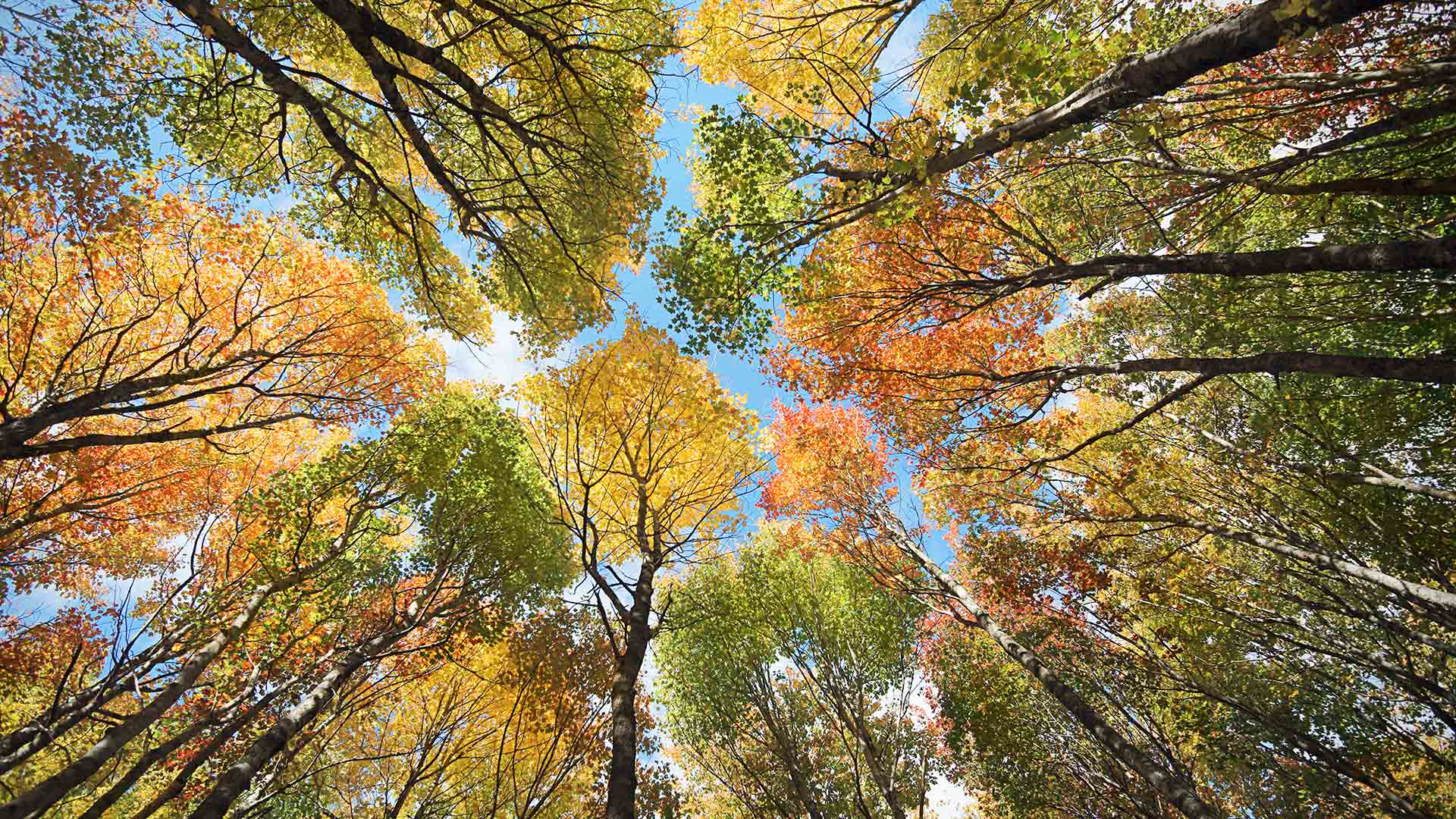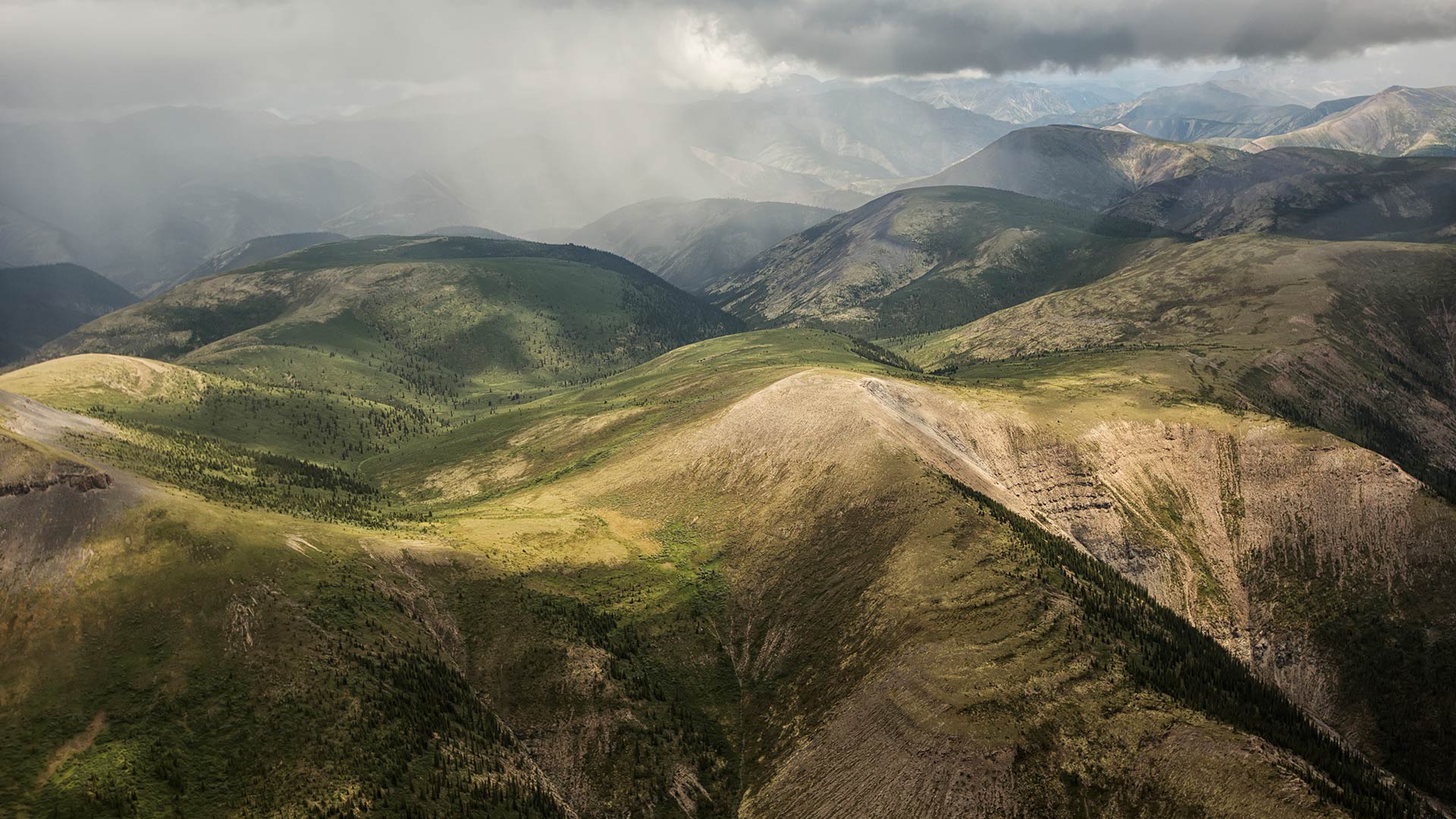拉莫里斯国家公园中的Wapizagonke湖区,加拿大魁北克 The Wapizagonke Lake in La Mauricie National Park, Quebec, Canada (© Instants/Getty Images)
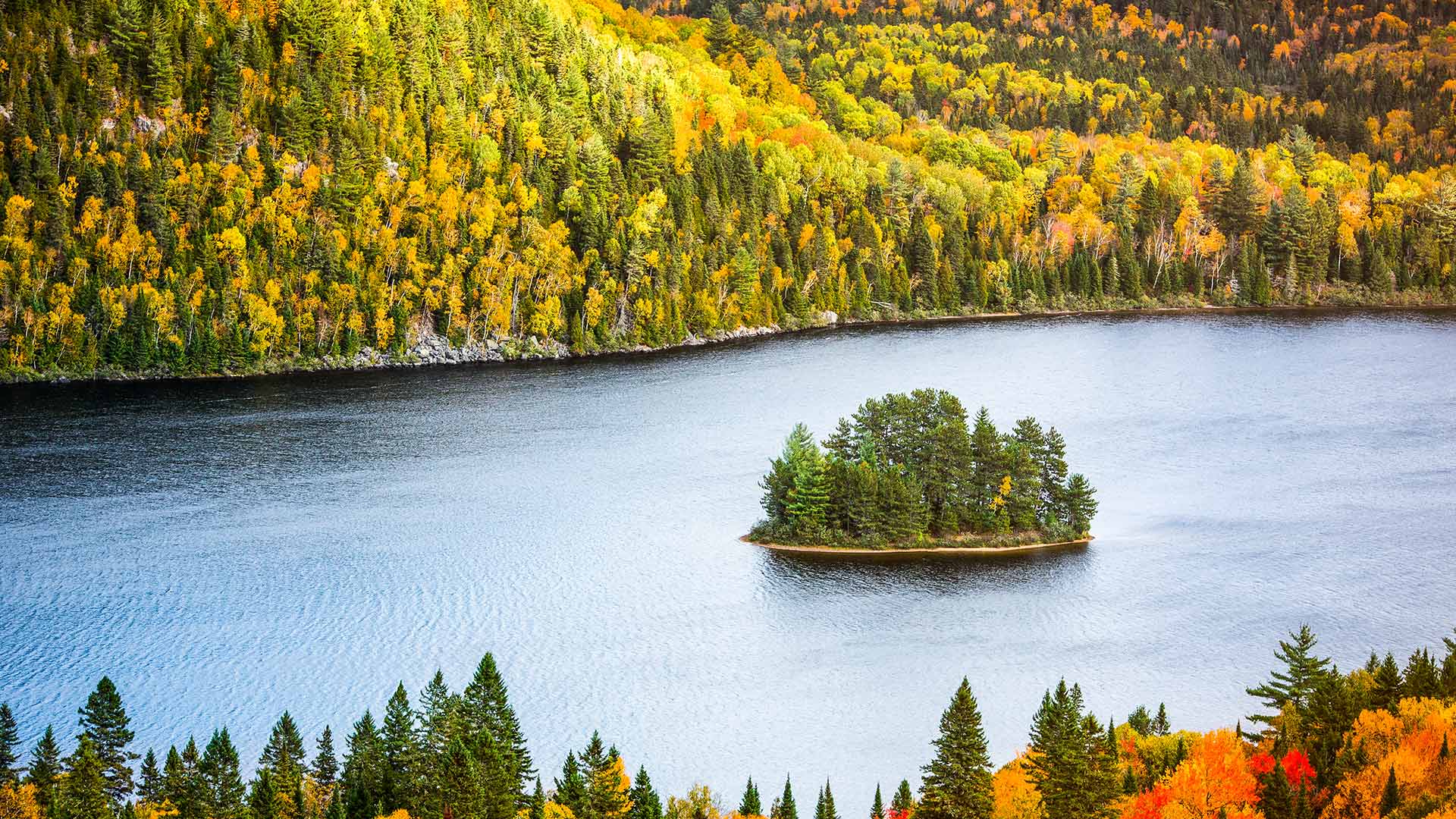
拉莫里斯国家公园中的Wapizagonke湖区,加拿大魁北克 The Wapizagonke Lake in La Mauricie National Park, Quebec, Canada (© Instants/Getty Images)
Vibrant colours of Fall
This majestic view of the Wapizagonke Lake encapsulates the spirit of autumn through the vibrant display of colours. Located between Québec City and Montréal, La Mauricie National Park is a site for all types of nature lovers. The park offers activities such as hiking, kayaking, paddling, bird watching, ice climbing and even star gazing. With more than 150 lakes and home to one of the oldest mountain ranges – the Laurentian Mountains - La Mauricie National Park is a destination filled with spectacular vistas all-year-round.
秋天的鲜艳色彩
瓦皮扎贡克湖的壮丽景色通过生动的色彩展示,体现了秋天的精神。La Mauricie国家公园位于魁北克市和蒙特勒尔之间,是各类自然爱好者的聚集地。公园里有徒步旅行、皮划艇、划船、观鸟、攀冰,甚至还有观星等活动。拉莫里西国家公园拥有150多个湖泊,是最古老的山脉之一——劳伦斯山脉的所在地,是一个终年景色壮观的目的地。
爱德华王子岛的森林和树冠,加拿大 (© OliverChilds/Getty Images)
注入海中的马更些河,加拿大 The Mackenzie River in Canada emptying into the Beaufort Sea (© Norman Kuring, GSFC/NASA/USGS Landsat)
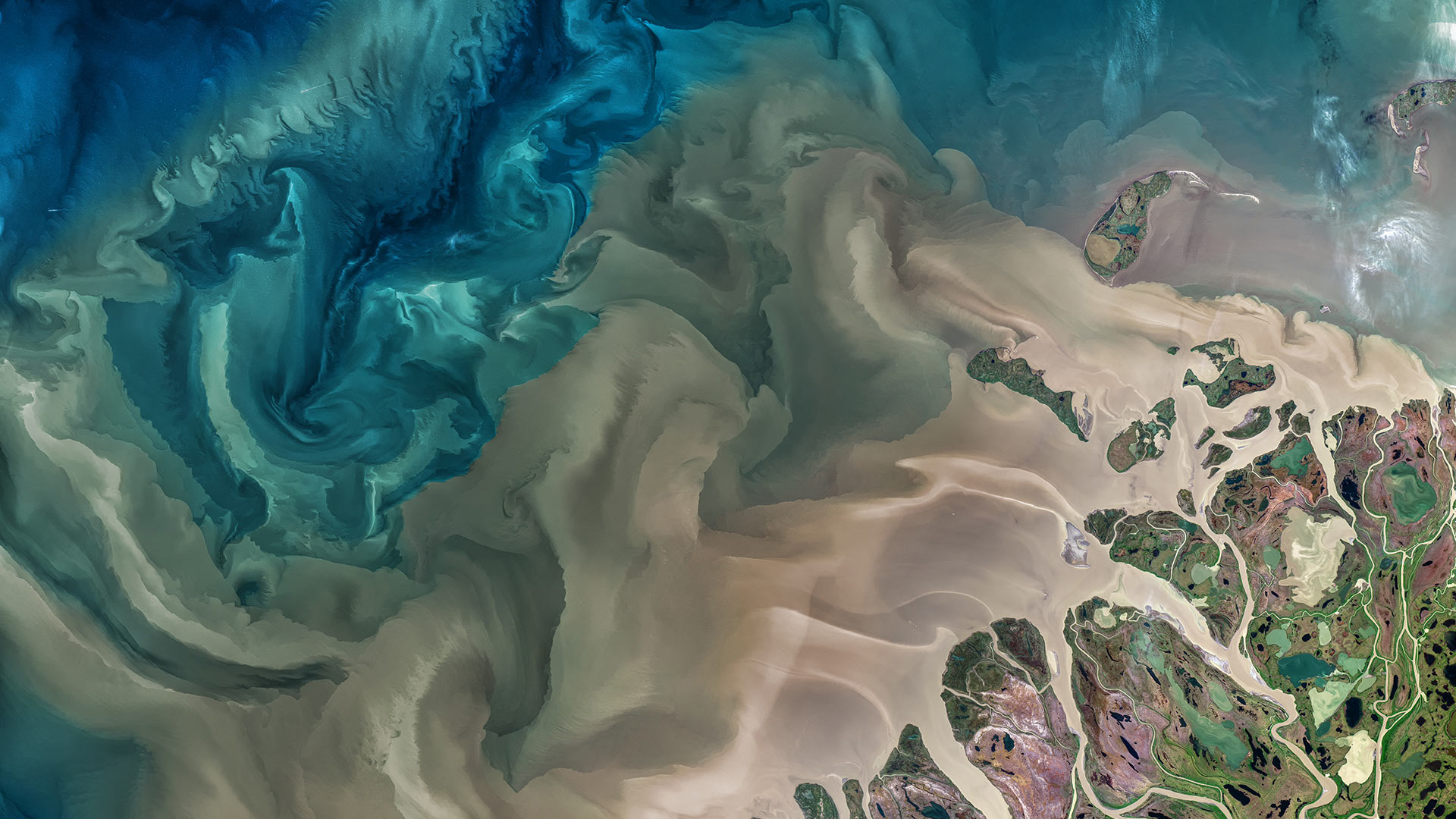
注入海中的马更些河,加拿大 The Mackenzie River in Canada emptying into the Beaufort Sea (© Norman Kuring, GSFC/NASA/USGS Landsat)
World Rivers Day
Today we're recognizing World Rivers Day, a celebration of our planet's waterways. The event branched off in 2005 from its source, BC Rivers Day, which has been observed by British Columbians in Canada since 1980. The annual event is now celebrated on the fourth Sunday of September by millions of people in more than 100 countries. It is a day that raises public awareness about rivers around the world and encourages their conservation.
Our photo, captured by NASA's Earth-imaging Landsat 8 satellite, shows part of the Mackenzie River delta and the river's turbid waters as they flow from the far north of Canada and Alaska into the Beaufort Sea in the Arctic Ocean. The Mackenzie River—the longest river in Canada and second-largest drainage basin of any North American river after the Mississippi–plays a vital role in modulating the Arctic climate as warmer fresh water mixes with colder seawater.
世界河流日
今天,我们要纪念世界河流日,这是一个庆祝地球水路的节日。这一活动于2005年从其源头——不列颠哥伦比亚河日开始,自1980年以来,加拿大的不列颠哥伦比亚人就一直在观察这一活动。现在,100多个国家的数百万人在9月的第四个星期日庆祝这项一年一度的活动。这一天提高了公众对世界各地河流的认识,并鼓励保护河流。
我们的照片由美国宇航局地球成像陆地卫星8号(Landsat 8)卫星拍摄,显示了麦肯齐河三角洲的一部分和河流的浑浊水域,它们从加拿大和阿拉斯加的最北部流入北冰洋的波弗特海。麦肯齐河是加拿大最长的河流,也是仅次于密西西比河的北美第二大流域,在调节北极气候方面起着至关重要的作用,因为温暖的淡水与寒冷的海水混合。
纳汉尼国家公园保护区的鸟瞰图,加拿大西北部 (© Robert Postma/Getty Images)
Manicouagan火山口, 魁北克加拿大 Manicouagan Crater in Québec, Canada (© Universal History Archive/Universal Images Group via Getty Images)
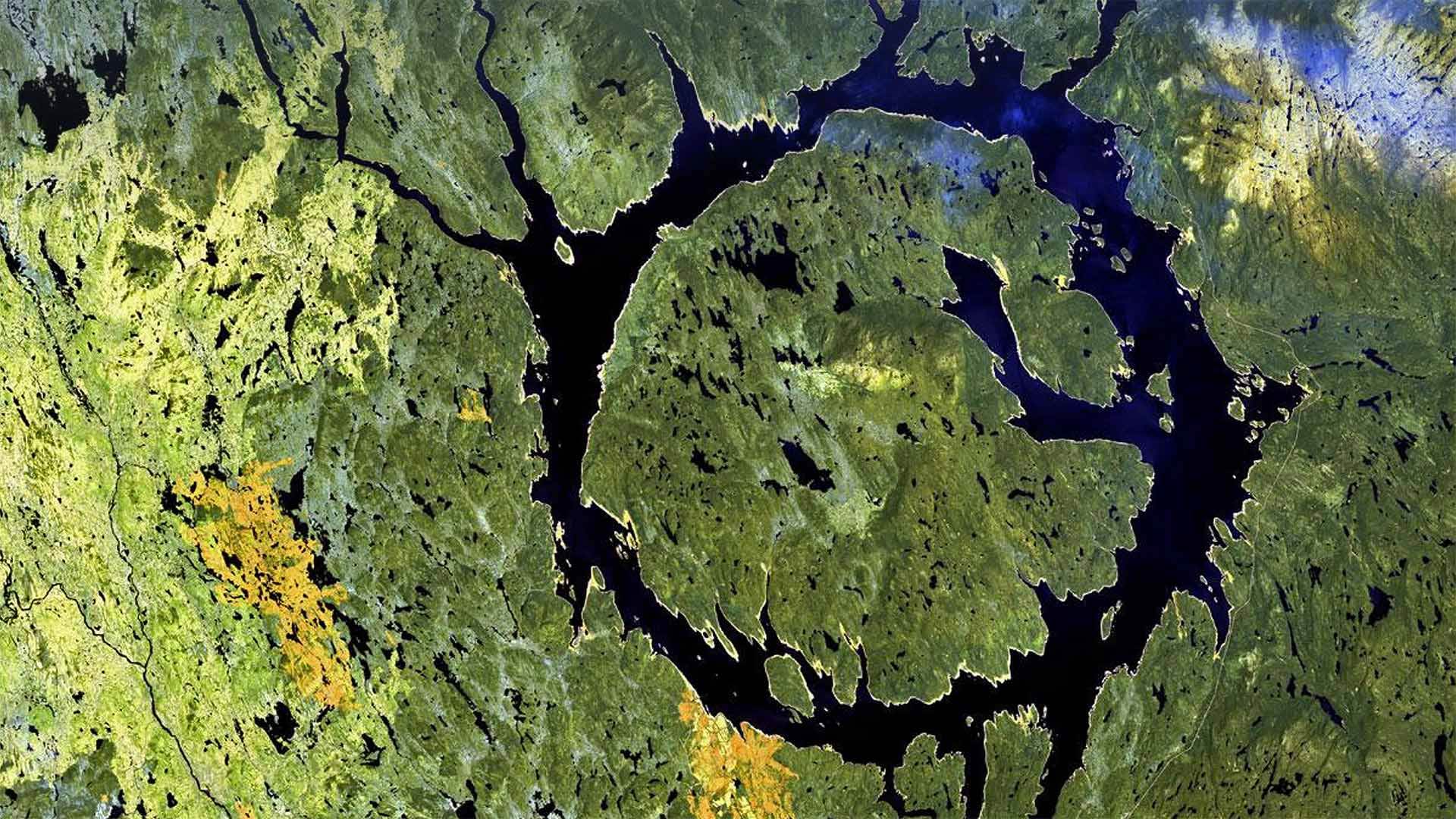
Manicouagan火山口, 魁北克加拿大 Manicouagan Crater in Québec, Canada (© Universal History Archive/Universal Images Group via Getty Images)
An impactful day
We'll be the ones to drop the news on you: It's Asteroid Day! Today you're invited to explore a realm of science usually encountered only through white-knuckle action flicks: Asteroid impact avoidance, or the study of what the heck we do if we spot a big chunk of space junk hurtling right at Earth. That's right, don't worry: People somewhere are coming up with plans for this.
Good thing, because as our photo shows, asteroid impacts do happen. Manicouagan Crater, aka the 'eye of Québec,' was formed by a 3-mile-wide meteorite that hit Earth about 215 million years ago. Much more recently, an explosive meteoroid leveled 800 square miles of Siberian forest in what's called the Tunguska event. It was 113 years ago today, and Asteroid Day's date was chosen in recognition.
So, if you find yourself casting paranoid glances at the sky today, maybe do a little searching on how scientists are learning to prevent potential impacts. Proposed plans involve everything from altering an asteroid's course via a gravitational field, to delaying its approach by attaching rocket thrusters, to good old-fashioned blowing it up. Yay science!
充实的一天
我们会把这个消息告诉你:今天是小行星日!今天,你被邀请去探索一个科学领域,这个领域通常只能通过白痴般的动作来实现:小行星撞击避免,或者研究如果我们发现一大块太空垃圾正朝地球飞来,我们该怎么办。是的,别担心:某地的人们正在为此制定计划。
好事情,因为正如我们的照片所示,小行星撞击确实发生过。Manicouagan火山口,又名“Qu之眼”é“bec”是由一块3英里宽的陨石形成的,它在大约2.15亿年前撞击地球。最近,在通古斯卡事件中,一个爆炸性流星体将800平方英里的西伯利亚森林夷为平地。那是113年前的今天,小行星日的日期被选为纪念日。
所以,如果你发现自己今天对天空投下了偏执的目光,或许可以做一些探索,看看科学家们是如何学会防止潜在的影响的。拟议中的计划涉及到从通过引力场改变小行星的轨道,到通过安装火箭推进器推迟其接近,再到老式的炸毁小行星的各种方法。耶,科学!
加拿大亚伯达省贾斯珀国家公园马利尼湖的精神岛 Spirit Island in Maligne Lake, Jasper National Park, Alberta, Canada (© Jeff Penner/EyeEm/Getty Images)
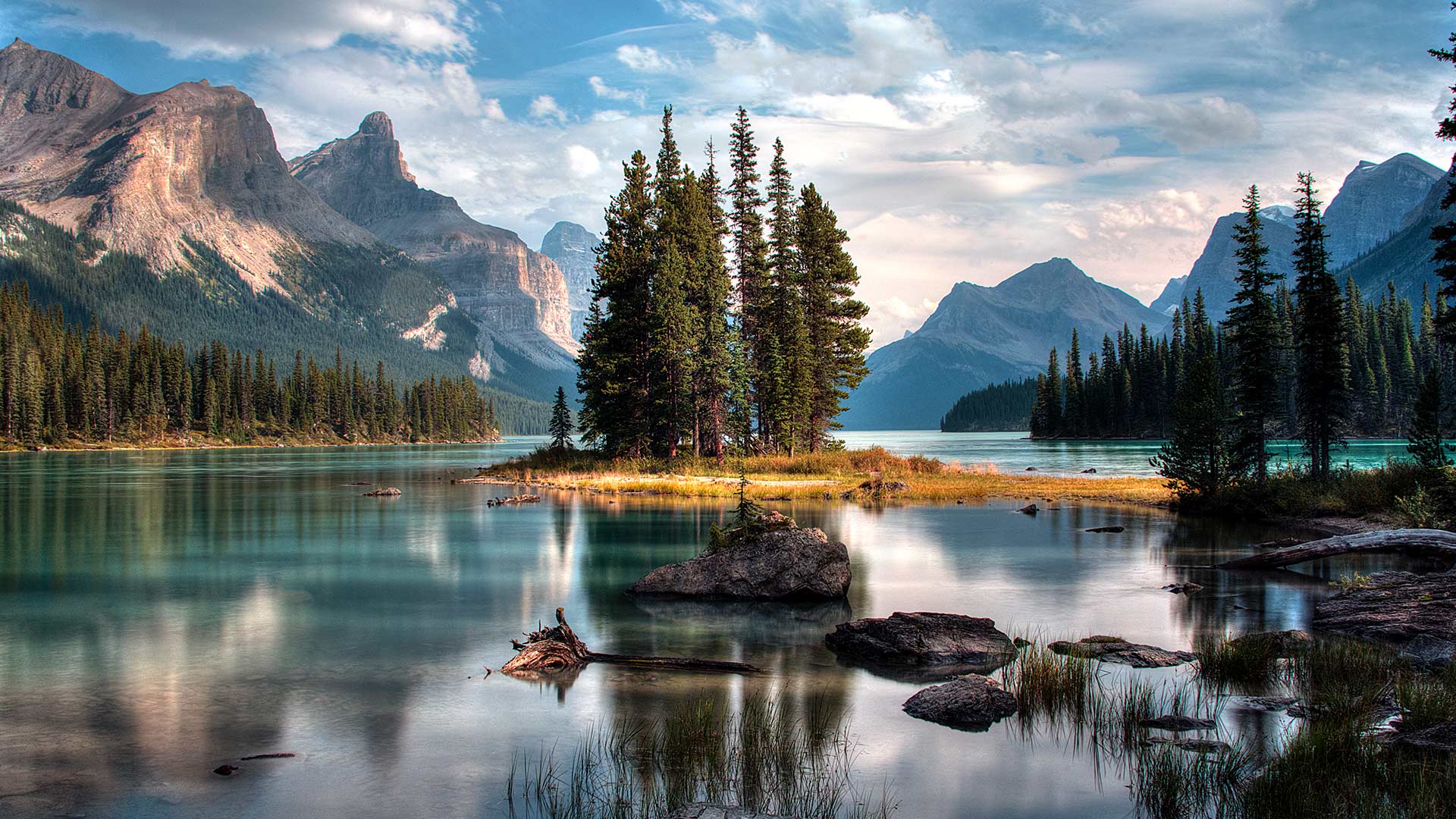
Spirit Island in Maligne Lake, Jasper National Park, Alberta, Canada (© Jeff Penner/EyeEm/Getty Images)
A photographer's paradise
If you are dreaming of an escape to paradise, look no further. Welcome to one of the most photographed sites in the majestic Canadian Rockies. Located in Jasper National Park in Alberta, the scenic Maligne Lake is 22 kilometres long, making it the largest natural lake out here. In the middle of this lake, sits the iconic Spirit Island which is only accessible via tour boats or private boats. The glacial, azure-blue waters, pine trees and snow-capped peaks frame Spirit Island, epitomizing the beauty of Jasper. In addition to admiring the natural beauty here, visitors can engage in activities such as hiking, fishing and kayaking during summer and skiing and snowshoeing in the winter.
摄影师的天堂
如果你梦想着逃往天堂,不要再看了。欢迎来到雄伟的加拿大落基山脉最受欢迎的景点之一。位于艾伯塔省贾斯珀国家公园,风景秀丽的马林湖长22公里,是这里最大的天然湖泊。在这个湖的中央,坐落着标志性的精神岛,只有通过旅游船或私人船只才能到达。冰川、湛蓝的海水、松树和白雪皑皑的山峰构成了精灵岛,是碧玉之美的缩影。除了欣赏这里的自然美景外,游客还可以在夏季进行徒步旅行、钓鱼和皮划艇活动,在冬季进行滑雪和雪鞋运动。
亚伯拉罕湖中的树,加拿大艾伯塔 Tree trunks in Abraham Lake, Alberta, Canada (© Coolbiere/Getty Images)
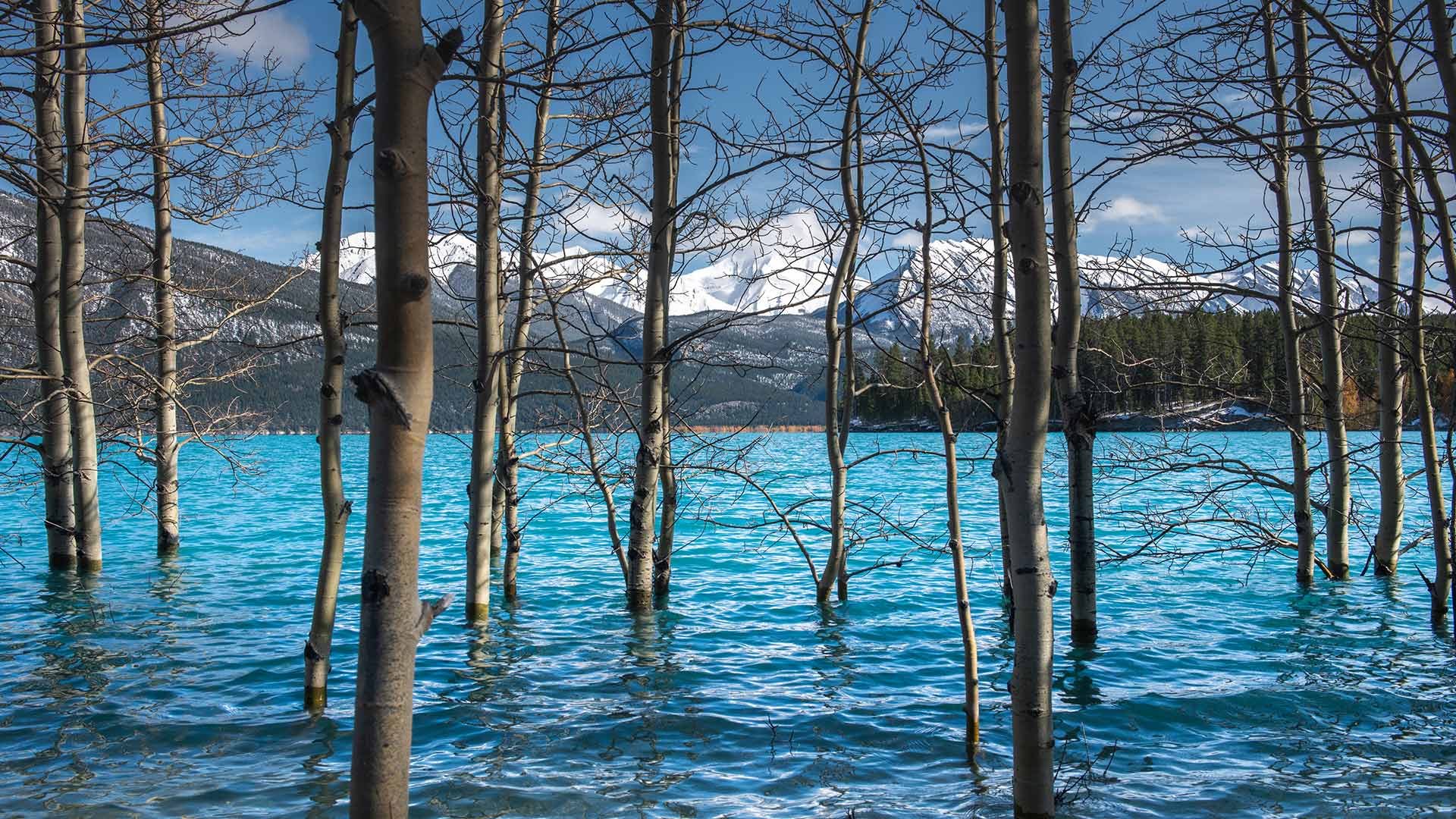
亚伯拉罕湖中的树,加拿大艾伯塔 Tree trunks in Abraham Lake, Alberta, Canada (© Coolbiere/Getty Images)
Lake and a reservoir
Today, we’re taking in views of Alberta’s largest reservoir – Abraham Lake. It was created in 1972 following the completion of the Bighorn Dam on the North Saskatchewan River. The dam was built by then Calgary Power Company, now TransAlta, to produce hydroelectric power. As seen here, Abraham Lake boasts a vivid shade of blue, further contributing to the breathtaking view with the mountains in the background. Of late, this gem in the Rockies has become a must-see for photographers every winter, for the emergence of the extraordinary frozen bubbles trapped under the lake. As the temperature drops, methane gas released from water-dwelling bacteria, forms into bubbles and freezes under the surface of the frozen lake. When the layer of ice on the lake is clear, the frozen bubbles can be seen and make for a remarkable spectacle.
湖和水库
今天,我们将欣赏艾伯塔省最大的水库——亚伯拉罕湖。它是1972年在北萨斯喀彻温河上的比格霍恩大坝完工后建造的。大坝由当时的卡尔加里电力公司(现为TransAlta)建造,用于生产水力发电。如图所示,亚伯拉罕湖拥有一个生动的蓝色阴影,进一步促进了以山脉为背景的惊险景色。最近,落基山脉的这块宝石每年冬天都成为摄影师们的必看之地,因为湖底出现了异常冰冻的气泡。随着温度下降,水中细菌释放出的甲烷气体形成气泡,冻结在结冰的湖面下。当湖面上的冰层清澈见底时,可以看到结冰的气泡,形成一种非凡的景象。
鸟瞰高耸入云的洛根山,加拿大克鲁瓦尼国家公园 Aerial image of Mount Logan rising above the clouds in Kluane National Park, Yukon, Canada (© plainpicture/Design Pics/Robert Postma)

鸟瞰高耸入云的洛根山,加拿大克鲁瓦尼国家公园 Aerial image of Mount Logan rising above the clouds in Kluane National Park, Yukon, Canada (© plainpicture/Design Pics/Robert Postma)
Walking in the clouds
Mount Logan is the highest mountain in Canada, and the second-highest peak in North America after Denali. The mountain was named after Sir William Edmond Logan, a Canadian geologist and founder of the Geological Survey of Canada (GSC). Logan is believed to have the largest base circumference of any non-volcanic mountain on Earth. Due to active tectonic uplifting, Mount Logan is still rising in height.
云中漫步
洛根山是加拿大的最高峰,也是北美仅次于德纳利的第二高峰。这座山是以加拿大地质学家、加拿大地质调查局(GSC)创始人威廉·埃德蒙德·洛根爵士的名字命名的。洛根被认为是地球上所有非火山山脉中基围最大的。由于活跃的构造抬升,洛根山仍在上升。
被北极光映衬出轮廓的因努伊特石堆,加拿大西北地区 Inukshuk silhouetted against the Northern Lights in Barren Lands, Northwest Territories, Canada (© Mark Duffy/Alamy)
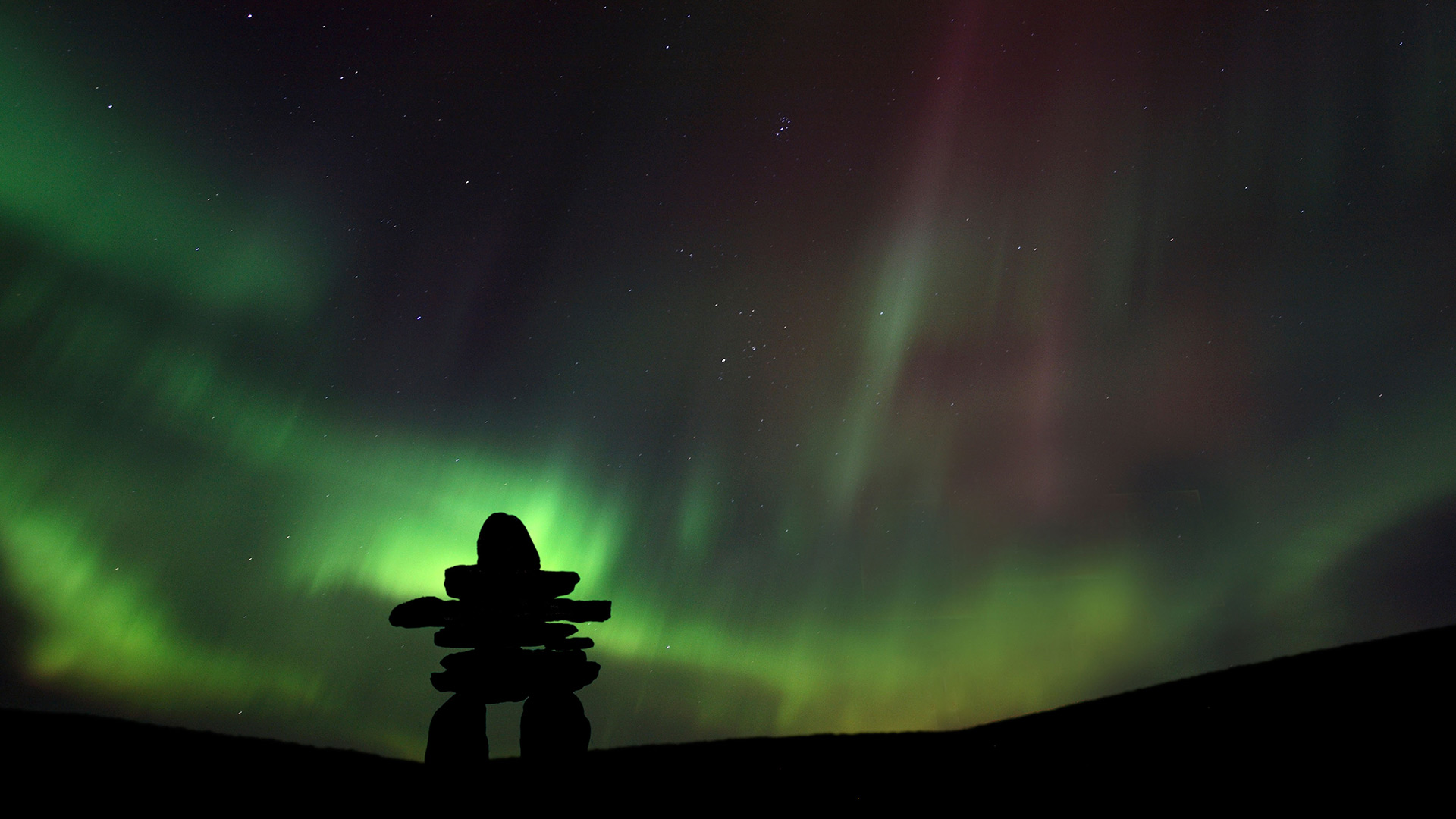
被北极光映衬出轮廓的因努伊特石堆,加拿大西北地区 Inukshuk silhouetted against the Northern Lights in Barren Lands, Northwest Territories, Canada (© Mark Duffy/Alamy)
A symbol of culture and communication
In Arctic Canada, an inukshuk is a monument that is built and placed by the Inuit who were the first people to inhabit the region. It is used as an aid for navigation, hunting tasks and sits as a centre for communication as well. An Inukshuk is made of stacked stones and is an integral part of the Inuit culture. Every stone in the structure has a purpose. It could be a warning of danger, pointing to a fishing spot or even indicating where food is hidden. Since the Inukshuk serves as an important form of communication, destroying one is strictly prohibited in Inuit culture.
The human-like stone figure pictured here is commonly mistaken to be an inukshuk. The Inuit call it inunnquaq, which refers to ‘in the likeness of a human.’ This structure consists of a figure that resembles a human with arms, legs and a head. While it doesn’t necessarily serve the same purpose as the inukshuk, it stands as a popular cultural symbol that was also used as an emblem for the 2010 Winter Olympics in Vancouver.
不列颠哥伦比亚省的一块南瓜田,加拿大 A pumpkin patch in British Columbia, Canada (© James Chen/Shutterstock)
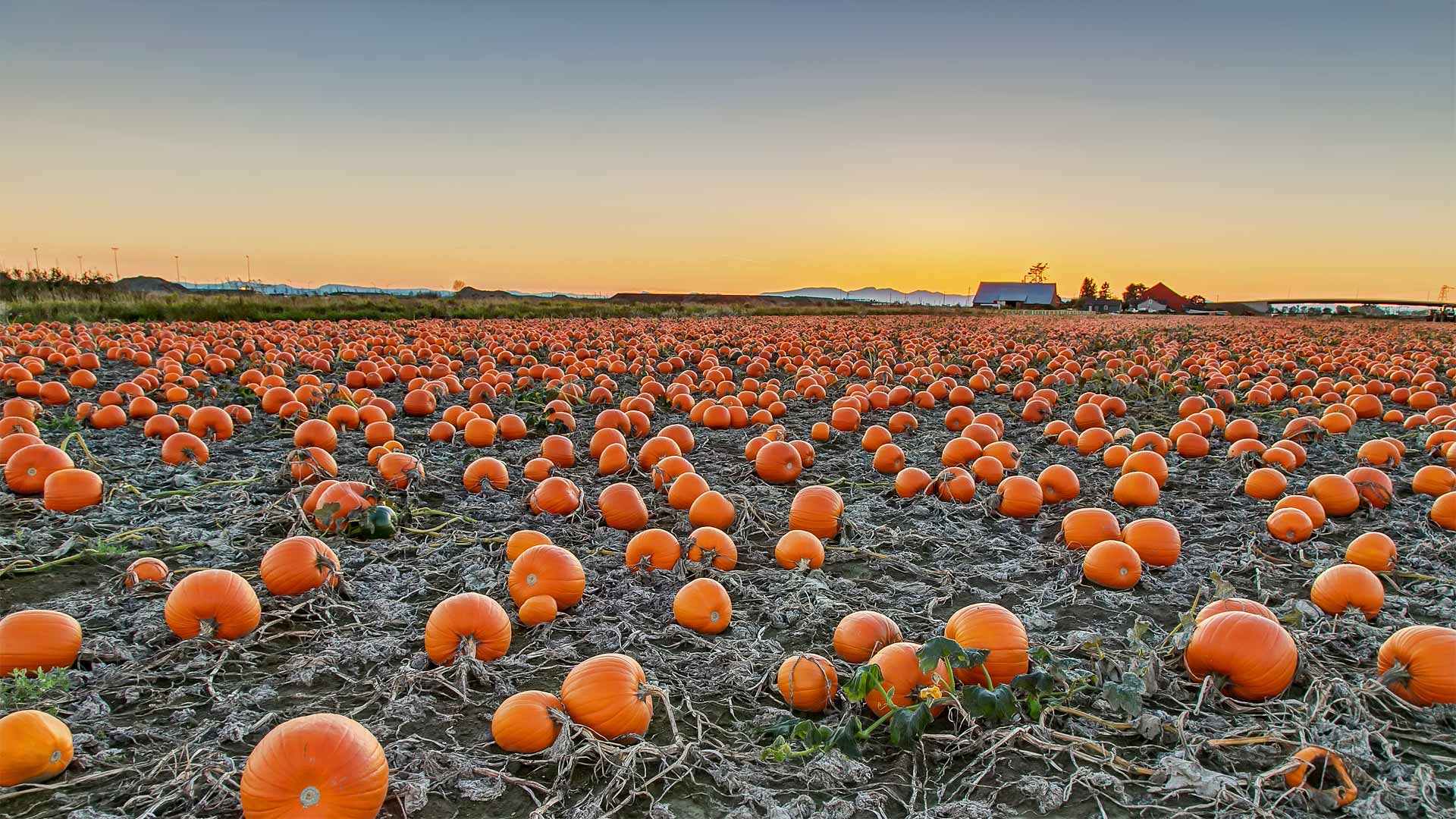
不列颠哥伦比亚省的一块南瓜田,加拿大 A pumpkin patch in British Columbia, Canada (© James Chen/Shutterstock)
A most sincere pumpkin patch
Ah, the perennial pumpkin patch. You might think the round orange gourds in today's photo are vegetables, but botanists say pumpkins are actually the fruit of pumpkin vines. They're considered fruit because pumpkins contain seeds and grow from the same part of the plant that produces flowers. And now, as Halloween nears, pumpkins are ripe for picking and carving into spooky jack-o'-lanterns.
The jack-o'-lantern tradition dates to mid-1800s Ireland when people carved faces into potatoes or turnips to ward off evil spirits. Irish immigrants brought the tradition to North America, only to discover that native pumpkins were much easier to carve. Fast-speed ahead and we're just grateful that pumpkins are the seasonal 'fruit' of choice since turnips would make a questionable spiced-latte drink.
